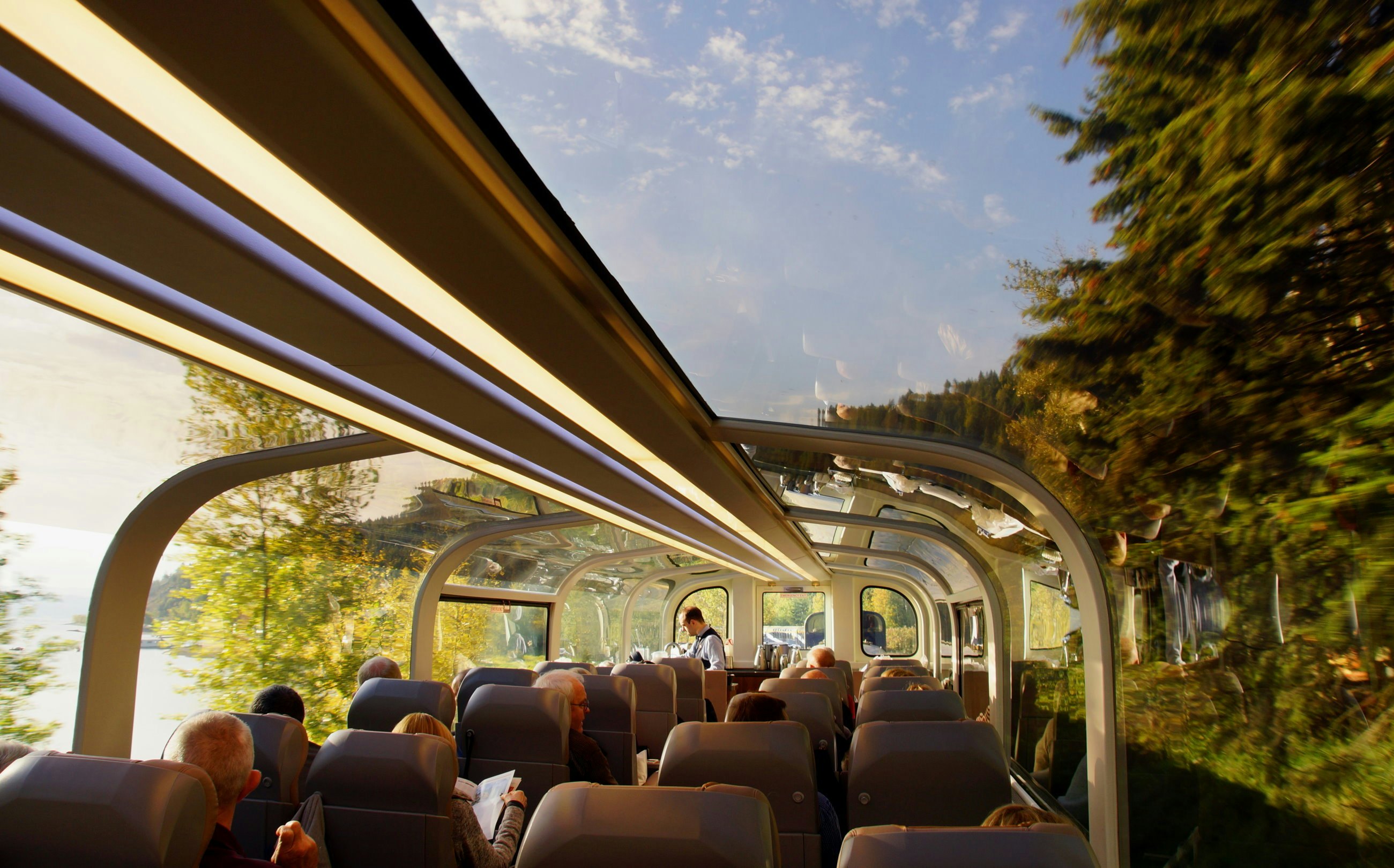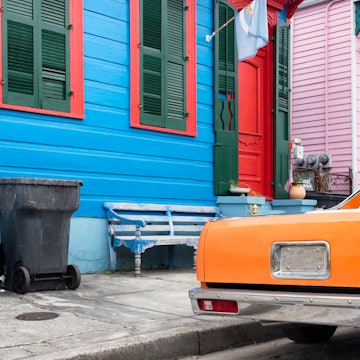

The Skeena train service crosses northern British Columbia in Canada. David Buzzard/Shutterstock
Train aficionados will be familiar with Canada’s extensive rail network and the continent-size country’s truly spectacular train rides.
Yet since most Canadians prefer to travel the long distances by car or plane, and with most of the rail network devoted to freight service, few travel from city to city outside of the eastern-corridor hubs of Toronto and Montréal.
While annual ridership on Canadian trains peaked at 60 million in the 1940s, today only around 5 million annual passengers take services operated by national carrier VIA Rail. Those in search of the glamor of train travel past can seek out more-deluxe journeys run by private companies – including the legendary Rocky Mountaineer, a veritable five-star hotel on wheels.
If you’re craving this or another rail adventure, read on for a full guide to train travel in Canada.

Canadian trains are comfortable but slow
While passengers praise the overall quality of service on Canadian trains, especially in business or sleeper classes, they should hardly expect bullet-train speeds. Obligated to yield to freight-train operators, who make up the bulk of the country’s rail traffic, passenger trains can spend long periods of time waiting on the sidelines, and often run late.
The fast intercity trains between Toronto, Ottawa and Montréal are exceptions, zipping along the eastern corridor route in just over five hours.
VIA Rail operates most services
The bulk of Canada’s rail network is run by VIA Rail, with a handful of private companies operating special lines, mostly for tourism. Several services from US rail operator Amtrak slip across the international border to serve Vancouver, Toronto and Montréal.
VIA Rail has two named trains: the cross-continental Canadian, one of the world’s great rail journeys – which links Vancouver and Toronto; and the Ocean, which carries passengers between Montréal and Halifax in Nova Scotia. The corporation also operates five Scenic Adventure routes that cater to both of tourists and rural residents who take advantage of flag stops (where the train stops by request only, often in the middle of nowhere).
Note that VIA Rail’s network does not extend to Prince Edward Island or Newfoundland and Labrador. Nor does it serve the territories – although those who make it to the Yukon might take the privately run White Pass and Yukon Route tourist train that travels in summer between Carcross and Skagway, Alaska.

VIA Rail carriages are generally comfortable, with large reclining seats and power outlets even in economy class. Long-distance overnight trains are particularly spacious; passengers also get access to a skyline car with a special dome section for panoramic views. Food and drink can be purchased at an on-board cafe.
Sleeper Plus class is available on the Canadian, the Ocean and Winnipeg–Churchill services; passengers can choose between open berths or one- or two-bed private compartments. Apart from the Winnipeg–Churchill service, overnight trains also include access to a special restaurant car, offering three meals per day (all included in the price of your ticket).
A step up from Sleeper Plus is Prestige Sleeper, only available on the Canadian, which delivers deluxe, hotel-style accommodation with private bathrooms, a mini bar, TVs and access to a private bullet lounge in the so-called “park car” at the back of the train.
Daytime trains in Canada’s eastern corridor offer either economy or business class. The latter includes meals and extra baggage allowance.

Montréal and Toronto are major rail hubs for commuters
Various commuter lines operate in the vicinity of Vancouver, Toronto and Montréal, all logging significantly higher passenger numbers than VIA Rail (up to 100 million per year in total). Vancouver is served by the West Coast Express, Toronto by GO Transit and Montréal by Exo.
While nowhere near as busy as rail networks in Europe, the corridor between Québec City and Windsor draws many passengers, particularly between Montréal and Toronto, Canada’s two largest cities. Outside of this trunk, Canadians take trains mostly for scenic journeys rather than for their commutes.
Scenic trains cater mostly to tourists
The five Scenic Adventure routes are the Jasper–Prince Rupert (the Skeena) in British Columbia; the Winnipeg–Churchill in Manitoba; the Sudbury–White River in Ontario; and the Montréal–Senneterre and Montréal–Jonquière routes in Québec. Many of these routes are sleepy: the Jasper–Prince Rupert line, for example, attracts just 7000 passengers a year.
Several private companies supplement VIA’s services. The most celebrated is the Rocky Mountaineer, whose swank trains run between Vancouver and Banff or Jasper. The “First Passage to the West” route is the only passenger train that currently runs on the original Canadian Pacific Railway tracks (the nation’s first cross-continental railway, completed in 1885) and passes through the legendary Spiral Tunnels in Yoho National Park. Of a similar bent is Royal Canadian Pacific, whose trains deliver cruise-ship-like luxury on multiday excursions. Since neither company has sleeper services, you’ll spend the night at hotels across the Rockies instead.
Ontario’s two private routes are the Algoma Central Railway, which provides access to the northern Ontario wilderness; and the Ontario Northland, which operates the Polar Bear Express five times a week.
The White Pass and Yukon Route between Carcross (Yukon) and Skagway (Alaska) dates from 1900 and follows the trail once trampled by feverish prospectors en route to the Klondike gold fields. Tapping into the old-timey vibes, diesel trains pull vintage, parlor-style carriages.
These are Canada’s best train routes

Rocky Mountaineer – First Passage to the West
The crème de la crème of Canadian train rides is operated by the Rocky Mountaineer, which supplements the astonishing landscape views with such luxury touches as leather seats, gourmet breakfasts and expert guides. This route – running between Banff and Vancouver with an overnight in Kamloops – is the operator’s most popular.
The Canadian
Canada’s most famous train chugs along a monumental cross-continental route that takes four days to cover 4466km (2775 miles) between Vancouver and Toronto, with stops in Jasper, Edmonton, Saskatoon and Winnipeg. The scenery is an unending nose-to-the-window display of the nation’s ever-changing ecosystems, from the Rocky Mountains to lonesome prairies to the lakes and forests of the Canadian Shield. Traveling from east to west allows for longer stops in Jasper and Edmonton.
White Pass and Yukon Route
This short but spectacular journey traverses the precipitous slopes of the White Pass, following the path forged by those who set out for the Klondike Gold Rush. Expect history in every respect: the heritage railway uses original parlor carriages dating from the 1880s. Grab a perch on the outside viewing platform as you descend into Skagway, across the border into Alaska.
The Skeena: train number 5
Cutting through the heart of British Columbia, VIA Rail’s train number 5 (formerly known as the Skeena) offers an epic two-day voyage between Jasper and Prince Rupert, incorporating coniferous forest, rolling farmland and snow-dusted mountains. (Locals use the line’s numerous flag stops en route.) A highlight is the view of the imposing southeast face of Mt Robson, an hour west of Jasper.
Winnipeg to Churchill
Canada’s most northerly passenger train service chugs arctic-ward across pancake-flat prairies and scattered boreal forest. The line provides the only overland connection to the polar-bear-watching hub of Churchill on the shores of Hudson Bay.
Tips on how to plan your next train trip in Canada

Book early for the best-value train tickets
Canadian trains are very reasonably priced for what they offer, particularly when compared to buses and planes. And among Canada’s three main modes of public transport – air, bus and train – the railway is easily the most comfortable.
June to mid-October is peak season, when prices are about 40% higher. Buying tickets in advance can yield significant savings (up to 30%) – and the earlier, the better. Book online using the official VIA Rail website. Alternatively, you can buy tickets at stations or by phone at 888-842-7245.
Seat reservations are highly recommended – especially in summer, on weekends and around holidays. During peak season, some of the most popular sleeping arrangements are sold out months in advance, especially on long-distance trains such as the Canadian. The Winnipeg–Churchill train often books solid during polar-bear season (around late September to early November).
Check to see if you qualify for a discounted ticket
Discounts are available for children under 12 (50%), Hosteling International members (12.5%), Canadian military (25%), Indigenous people (33%), Canadian Automobile Association members (up to 20%) and groups of 10 or more. Children under 2 travel free. (Be sure to bring all relevant ID when traveling.) There are currently no rail passes on Canadian trains, though frequent travelers can sign up for VIA Préférence and collect points toward future trips.
Train tickets don’t cost any more than car rentals
Like the USA, Canada is a car-oriented country – and plenty of Canadians go their whole lives without using an intercity train, especially in the West. While it’s easy to rent a car in Canada and enjoy the country‘s great roads, trains emit less carbon per person (55kg of CO² compared with 104kg for a car) and are marginally quicker on the fast intercity routes along the eastern corridor. Once you factor in the cost of fuel, a car rental is about the same price as a train ticket.
Most urban train stations in big cities are close to the downtown cores, with good onward transport connections. Additionally, most large stations have a car-rental desk if you want to continue by car after your train trip.

Expect a comfortable ride once on board
All VIA Rail trains have some form of onboard food provision, from cafes and trolleys on daytime routes to restaurant cars on the overnight Canadian and Ocean services. Free wi-fi is available on most trains (although it can be patchy in some areas). Blankets and pillows are provided for overnight travel, with extra comfort the norm in business class on the Ontario/Québec corridor and Sleeper Plus on the Canadian and the Ocean.
VIA Rail baggage rules are similar to what you’ll find on airplanes. You can bring a carry-on of up to 23kg (50lbs) for free. Checked luggage is C$25 (US$17.35) per bag. Small folding bikes are considered carry-on luggage; all other bikes incur a C$25 (US$17.35) checked-baggage fee.
Book ahead if you have accessibility needs or special requirements
All VIA Rail trains are accessible for wheelchairs and have toilets with grab-bars. Most stations have wheelchair lifts. Passengers who can’t make it to the restaurant car may be served meals in their seats. Service dogs are welcome on trains and can occupy an additional seat at no extra cost.
Book well ahead for accessible facilities and cite any special requirements in advance, as space may be limited. For more information, visit VIA Rail’s accessibility page.
















